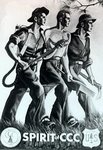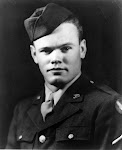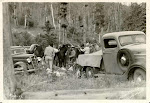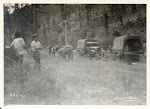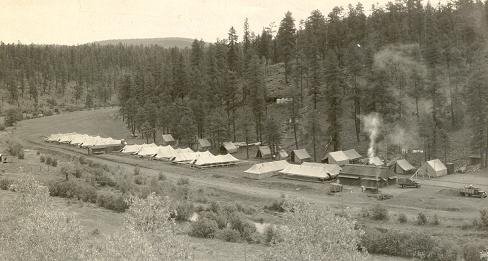Life in a Civilian Conservation Corps side camp could be rustic to say the least. In this post we'll take a brief look at how the side camps were set up.

While most CCC camps were situated close to the main project site where the enrollees worked, there were also many, many work sites in remote places that needed the attention of CCC workers. It simply wasn’t practical to transport enrollees over miles and miles of remote roads to these work sites, and then return to camp at the end of the workday. To resolve this dilemma, smaller camps known as “spike camps,” “side camps,” or “fly camps” were established. But no matter what they were called, those small non-permanent camps established well away from larger CCC camps, were responsible for an astonishing amount of useful work that otherwise would not have been possible.
Side camps were initially an area of dispute. The technical services wanted the side camps placed under their control, an arrangement that both the Army and director Fechner opposed. Since the operation of the main camps was under their control, the Army reasoned that it should also be in charge of the side camps, with the technical services taking charge of the enrollees during normal work hours.
In July1933, President Roosevelt approved the establishment of side camps and he placed them under the control of the technical agencies with the requirement that not more than 10 percent of the company strength be assigned to them. One reason for Roosevelt’s decision may have been that, to place an army officer in each side camp would have stretched the military organization too thin, leading to a decline in management and leadership throughout the program. Despite their being exempt from direct Army control, there were guidelines on the layout of the side camps. For example, a Forest Service plan for a 25-man camp provided for five canvas tents, each 16 by 16 feet to house the enrollees. Three tents measuring 9 by 9 feet provided shelter for supervisory staff. The mess unit operated out of a tent measuring 19 by 21 feet and additional shelters were provided for the kitchen, the cook, the infirmary and office, as well as latrine and shower facilities. Even in these smaller camps, the provision was always made for a flagpole, usually placed in a central location in the camp area.
Forest Service plans also provided guidelines for a mobile 25-man camp, which consisted of 12 two-man shelter tents, three staff tents, one cook tent and a tent to serve as a combination mess and kitchen. Despite the lack of Army involvement, life in a mobile camp may have been quite similar to life in an infantry platoon. Each man was to be supplied with an infantry pack, canteen and mess kit. In the mobile configuration, the need for a kitchen unit could be eliminated if each enrollee carried five days of rations with him and the crew returned to base camp on weekends to re-provision.
Side camps were initially an area of dispute. The technical services wanted the side camps placed under their control, an arrangement that both the Army and director Fechner opposed. Since the operation of the main camps was under their control, the Army reasoned that it should also be in charge of the side camps, with the technical services taking charge of the enrollees during normal work hours.
In July1933, President Roosevelt approved the establishment of side camps and he placed them under the control of the technical agencies with the requirement that not more than 10 percent of the company strength be assigned to them. One reason for Roosevelt’s decision may have been that, to place an army officer in each side camp would have stretched the military organization too thin, leading to a decline in management and leadership throughout the program. Despite their being exempt from direct Army control, there were guidelines on the layout of the side camps. For example, a Forest Service plan for a 25-man camp provided for five canvas tents, each 16 by 16 feet to house the enrollees. Three tents measuring 9 by 9 feet provided shelter for supervisory staff. The mess unit operated out of a tent measuring 19 by 21 feet and additional shelters were provided for the kitchen, the cook, the infirmary and office, as well as latrine and shower facilities. Even in these smaller camps, the provision was always made for a flagpole, usually placed in a central location in the camp area.
Forest Service plans also provided guidelines for a mobile 25-man camp, which consisted of 12 two-man shelter tents, three staff tents, one cook tent and a tent to serve as a combination mess and kitchen. Despite the lack of Army involvement, life in a mobile camp may have been quite similar to life in an infantry platoon. Each man was to be supplied with an infantry pack, canteen and mess kit. In the mobile configuration, the need for a kitchen unit could be eliminated if each enrollee carried five days of rations with him and the crew returned to base camp on weekends to re-provision.
